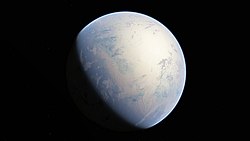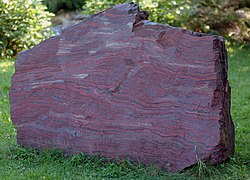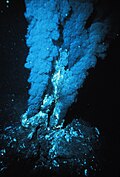Snowball Earth
Snowball Earth or Icehouse Earth refers to times when the Earth's surface was nearly or entirely frozen. The occurrence of Snowball (or Slushball) Earths is still controversial. However, it is probable that widespread glaciation occurred in periods of the Proterozoic.
What is debatable is how widespread those glaciations were. Proponents claim the theory explains sedimentary deposits of glacial origin at tropical latitudes and other strange features of the geological record.
Opponents do not draw the same inferences from the geological evidence, and doubt the geophysical feasibility of an entirely ice or slush-covered ocean.[1]
Palaeoproterozoic
- Huronian glaciation 2,400 – 2,100 million years ago (mya)
The Snowball Earth hypothesis explains glacial deposits in the Huronian supergroup of Canada. The palaeomagnetic evidence, which suggests ice sheets at low latitudes, is contested.[2][3] The glacial sediments of the Makganyene formation of South Africa are slightly younger than the Huronian glacial deposits (~2,250 million years old) and were deposited at tropical latitudes.[4]
Causes
The rise of free oxygen occurred during this part of the Paleoproterozoic. Perhaps purple bacteria removed methane from the atmosphere through oxidation. As the Sun was notably weaker at the time, methane, a powerful greenhouse gas, had kept surface temperatures above freezing. In the absence of this methane greenhouse effect, temperatures plunged and a snowball event could have occurred.[3] This happened because the methane gas and carbon dioxide in the air first combined with water vapor. This precipitated as acid rain, and made carbon chemicals when the acid rain reached surface water. Afterward, the carbon chemicals formed limestone deep underwater. Cyanobacteria active at the time also took part in the freezing process by converting carbon dioxide to oxygen. The ice itself made its expansion unstoppable. Glaciers reflect 85% of the light coming toward them, and also reflect the light's energy. Lower energy and heat from the sun made the glacier get stuck in a cycle of growing. [5]
Ending
The period of this extraordinary ice age, Snowball Earth, finally ended when a series of volcanic eruptions occurred. The volcanoes made holes through the ice sheets. The greater effect these eruptions made are the mass releasing of carbon dioxide into the air. The planet reheated, and Earth was saved from being a ball of ice. [6]
Effects
Cyanobacteria and other forms of life might have died out in Snowball Earth. But the cyanobacteria may have survived in warmer areas, such as inside caves. When the ice on snowball Earth melted, the percentage of oxygen in the atmosphere rose from 1% to 21%. This is so, because in the time of Snowball Earth, cyanobacteria adapted to the darkness of caves, where sunlight is scarce. When Snowball Earth ended, the surviving cyanobacteria were descendants of cyanobacteria that had been better at photosynthesis (the converting of water and carbon dioxide and light (photons) into sugar and oxygen). The great amount of light after the long period of darkness was enough for the cyanobacteria to make huge progress.[7] With more oxygen, living things were able to develop more complex anatomies. This continued evolution led to plants and insects and animals like those we see today.
Neoproterozoic
- Kaigas ice age 825 – 730 mya
- Sturtian ice age 720 – 635 mya
- Marinoan ice age 650 – 635 mya
There were three or four significant ice ages during the late Neoproterozoic.[8] Of these, the Marinoan was the most significant, and the Sturtian glaciations were also truly widespread. These were both in the Cryogenian period, before the Ediacaran.[9] The million year long Gaskiers glaciation did not lead to global glaciation,[10] although it was probably as intense as the late Ordovician glaciation. The status of the Kaigas glaciation or "cooling event" is unclear. Some do not recognise it as glacial, and others believe it may indeed be a third ice age. It was certainly less significant than the Sturtian or Marinoan glaciations, and probably not global in extent. Evidence does suggest that the Earth underwent a number of glaciations during the Neoproterozoic.[11]
Snowball Earth Media
Diamictite of the Neoproterozoic Pocatello Formation, a "snowball Earth"-type deposit
Elatina Fm diamictite below Ediacaran GSSP site in the Flinders Ranges NP, South Australia. A$1 coin for scale.
Volcanoes may have had a role in replenishing Template:Co2, possibly ending the global ice age of the Cryogenian Period.
Simulation with liquid water around the equator
A black smoker, a type of hydrothermal vent
References
- ↑ Harland, W.B. (2007). "Origin and assessment of snowball Earth hypotheses". Geology Magazine. 144 (4): 633–642. Bibcode:2007GeoM..144..633H. doi:10.1017/S0016756807003391. S2CID 10947285.
- ↑ Williams G.E. & Schmidt P.W. (1997). "Paleomagnetism of the Paleoproterozoic Gowganda and Lorrain formations, Ontario: low palaeolatitude for Huronian glaciation" (PDF). EPSL. 153 (3): 157–169. Bibcode:1997E&PSL.153..157W. doi:10.1016/S0012-821X(97)00181-7. Archived from the original (PDF) on 2016-06-09. Retrieved 2009-12-21.
- ↑ 3.0 3.1 Robert E. Kopp, Joseph L. Kirschvink, Isaac A. Hilburn, and Cody Z. Nash (2005). "The Paleoproterozoic snowball Earth: a climate disaster triggered by the evolution of". PNAS. 102 (32): 11131–11136. Bibcode:2005PNAS..10211131K. doi:10.1073/pnas.0504878102. PMC 1183582. PMID 16061801.
{{cite journal}}: CS1 maint: multiple names: authors list (link) - ↑ Evans D.A. Beukes N.J. & Kirschvink J.L. 1997. Nature 386, 262–266.
- ↑ "NASA GISS: Research Features: "Snowball Earth" Might Have Been Slushy". www.giss.nasa.gov. Retrieved 2024-02-26.
- ↑ Gernon, Thomas (2016-01-20). "How 'Snowball Earth' Came to a Fiery End | RealClearScience". www.realclearscience.com. Retrieved 2024-02-26.
- ↑ "Snowball Earth and the rise of oxygen". FutureLearn. Retrieved 2024-02-26.
- ↑ "New evidence supports three major glaciation events in the distant past". ScienceDaily. 2004-04-22. Retrieved 2011-06-18.
- ↑ Stern R.J. Avigad D. Miller N.R. Beyth, M. (2006). "Geological Society of Africa Presidential Review: Evidence for the Snowball Earth hypothesis in the Arabian-Nubian shield and the East African orogen". Journal of African Earth Sciences. 44: 1–20. doi:10.1016/j.jafrearsci.2005.10.003.
{{cite journal}}: CS1 maint: uses authors parameter (link) - ↑ Hoffman P.F. (2005). "On Cryogenian (Neoproterozoic) ice-sheet dynamics and the limitations of the glacial sedimentary record". South African Journal of Geology. 108: 557–577. doi:10.2113/108.4.557.
- ↑ Allen, Philip A. (2008). "Sedimentary challenge to Snowball Earth". Nature Geoscience. 1 (12): 817–825. Bibcode:2008NatGe...1..817A. doi:10.1038/ngeo355.










